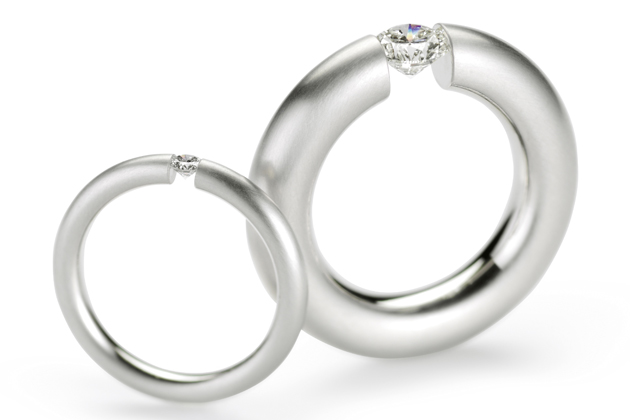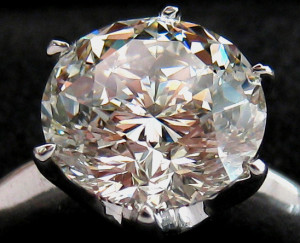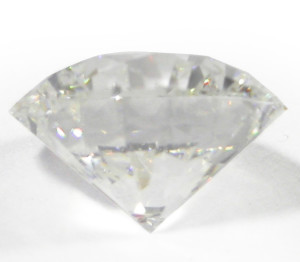 Fascinée par les pierres de couleur, j’ai longtemps délaissé les solitaires hautement symboliques jusqu’au jour où je découvris le diamant de couleur. Je travaillais alors à Londres et la visite d’une exposition de diamants organisée par la mine australienne d’Argyle a changé à jamais mon regard sur le diamant…
Fascinée par les pierres de couleur, j’ai longtemps délaissé les solitaires hautement symboliques jusqu’au jour où je découvris le diamant de couleur. Je travaillais alors à Londres et la visite d’une exposition de diamants organisée par la mine australienne d’Argyle a changé à jamais mon regard sur le diamant…
L’autre événement qui a compté pour moi est une conférence du diamantaire Gabi Tolkowsky. Ecouter cet homme évoquer le diamant est envoûtant et permet de comprendre que cette pierre phénoménale, loin de se réduire à un éclat insurpassable et à un prix qui l’est tout autant, peut devenir une œuvre d’art entre les mains d’un artiste et mathématicien. Gabi Tolkowsky a passé sa vie à inventer de nouvelles tailles aux bien jolis noms : Dahlia, Marigold ou encore « Gabrielle » une merveille de 105 facettes. 105 facettes, sur un si petit volume, quelle précision ! Presque deux fois plus de facettes que dans la taille « brillant » moderne, mise au point par son grand-oncle Marcel, au début du 20ème siècle… Pourrai-je un jour contempler une pierre taillée par Gabi ?
Mais revenons au diamant. Ce blog n’a nulle intention de rivaliser avec les nombreux articles disponibles sur internet. Je ferai donc comme avec mes étudiants : extraire les 3 ou 4 notions essentielles qu’il est indispensable de connaître.
1. Origine
Le diamant, élément composé de carbone pur (C), s’est formé sur terre il y plus de 600 millions d’années (souvent 1 à 2 milliards). Il vient des profondeurs de la planète, (à plus de 150 kilomètres et jusqu’à 1000 kms), là où le magma est soumis à des conditions de température et de pression très élevées. Le diamant remonte par des cheminées de volcans. Seuls les diamants qui ont voyagé suffisamment vite (2000 km/h) ont survécu à ce parcours périlleux. Une fois à la surface du globe, l’érosion désagrège les roches et charrie les cristaux de diamants dans les cours d’eau et parfois jusqu’à la mer. A côté des diamants « terrestres », on a trouvé de très rares spécimens et le plus souvent minuscules (des nano-diamants) dans des météorites.
2. La formation du prix, les 4 C
Le diamant « blanc » est la seule pierre précieuse pour laquelle il existe un tarif mondial. Le prix est fondé sur des critères de jugement relativement objectifs de couleur, pureté, qualité de la taille / proportions et de poids. (Les 4 C, en anglais : Colour, clarity, cut, carat).
- Colour, la couleur des diamants blancs est notée de « D », la plus rare, un blanc exceptionnel à « Z » (gris jaune),
- Clarity, la pureté, de « IF » (pour Internally Flawless) ou pur à la loupe grossissement 10 fois à « P3 » (piqué de nombreuses inclusions),
- Cut, la qualité de la taille, mesure le respect des proportions, des angles, de l’épaisseur du rondiste, la symétrie et le poli …
- Carat, c’est-à-dire le poids, en carats. Le carat équivalant à 0,20 gramme.
Le prix est généralement donné par carat et il augmente mécaniquement avec le poids car, pour une même qualité, l’augmentation de poids est un facteur de rareté. Donc un diamant 2 fois plus gros qu’un autre, peut valoir 3 à 4 fois plus, pour la même qualité.
La taille « brillant », ronde, est la plus courante. Un brillant « moderne » est taillé en 57 facettes et une pierre de 1 carat mesure 6mm de diamètre.
En ce qui concerne sa couleur, l’œil non professionnel commence à distinguer le changement de teinte après 5 gradations. Le prix, d’une pierre de 1 carat aura pu chuter d’environ 30% dans l’intervalle.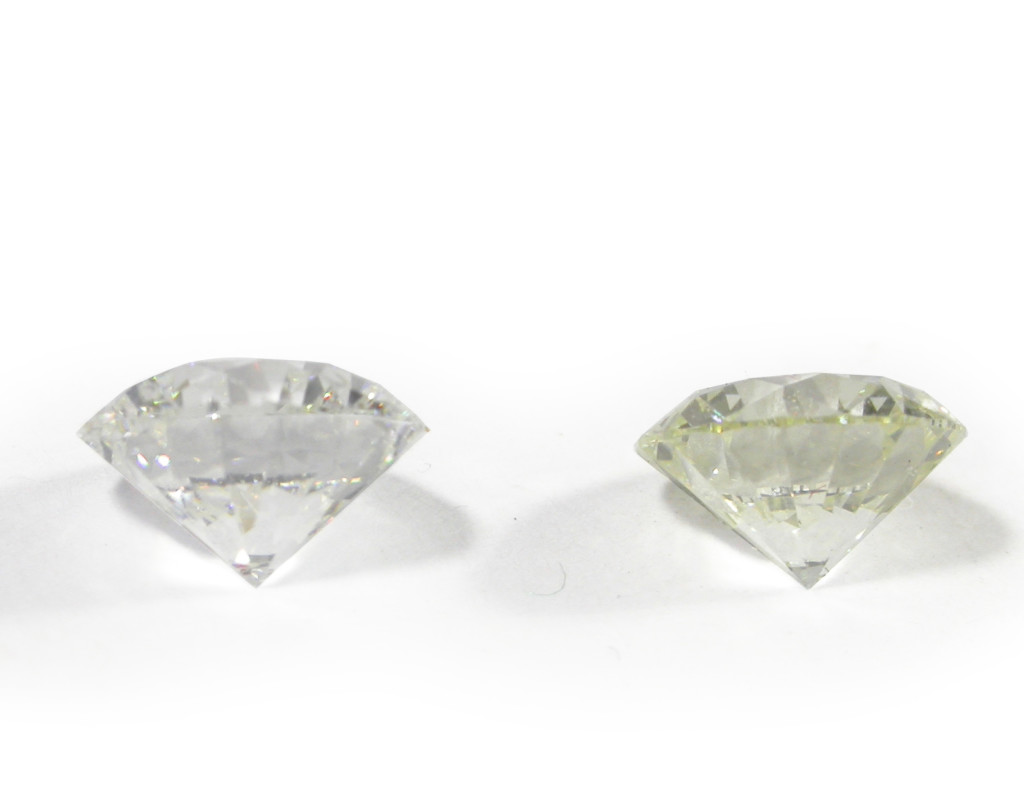
Le 1er diamant est de couleur G blanc extra, le 2ème est « L », légèrement teinté.
Exemples de prix donnés par notre diamantaire.
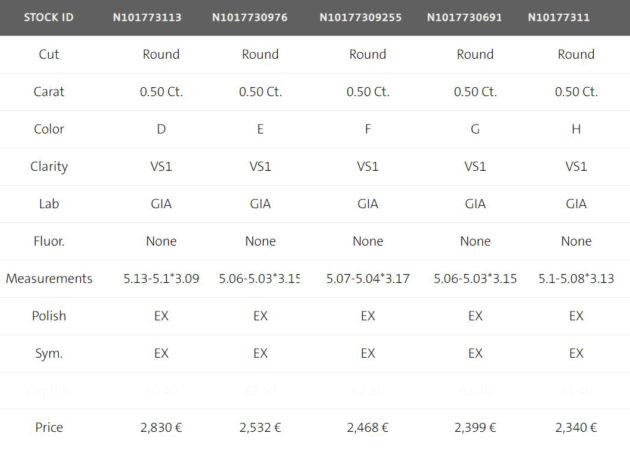
Ces caractéristiques sont annoncées par le professionnel, elles peuvent être également attestées par un certificat. Cependant toute la personnalité d’un diamant ne peut être résumée par quelques mesures. Chaque pierre joue avec la lumière de façon distincte et les grands professionnels ne sont pas des amateurs de certificat. Quand on choisit une pierre en confiance, il faut aussi faire confiance à son œil, apprivoiser la lumière et se laisser charmer, sans forcément choisir la pierre aux meilleures caractéristiques, d’autant que pour telle monture ou tel type de bijou, la meilleure couleur pourra primer, tandis que pour un autre bijou, c’est la pureté ou la qualité de la taille qui primera.
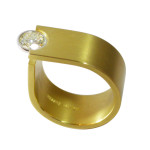 Un diamant légèrement jaune verra sa couleur « absorbée » dans un bijou en or jaune, tandis qu’une monture en platine ou en or gris magnifiera les diamants les plus blancs. Le diamant sur cette photo est de couleur L… Qui l’eut cru ? La cliente a préféré privilégier la pureté.
Un diamant légèrement jaune verra sa couleur « absorbée » dans un bijou en or jaune, tandis qu’une monture en platine ou en or gris magnifiera les diamants les plus blancs. Le diamant sur cette photo est de couleur L… Qui l’eut cru ? La cliente a préféré privilégier la pureté.
3. Dureté et solidité
Le diamant (adamas) tire son nom du grec « Adamas » qui signifie invincible. C’est un immense malentendu. Sa dureté, la plus élevée de tout l’univers, est une résistance à la rayure, donc à la taille et au polissage. Un diamant ne peut être rayé que par une autre diamant, mais ce n’est aucunement une assurance contre la casse, relativement aisée parfois ! Attention donc aux chocs ! Et, bien sûr, le diamant, carbone, brûle pour peu que la flamme soit assez vive et dure assez longtemps.
« Un diamant est éternel », la fameuse devise publicitaire inventée par l’agence de publicité de la compagnie De Beers en 1947, est un puissant message qui a largement pénétré l’esprit de nombreux couples qui n’envisageraient pas de célébrer leur amour autrement… Si l’on peut rêver qu’il sublime un amour, ou qu’il en soit le très digne symbole en passant de génération en génération, il n’en demeure pas moins qu’il faut en prendre soin… comme de la personne aimée.
4. Des diamants de couleur
Le diamant existe dans toutes les couleurs jusqu’au noir, de façon naturelle. Mais, à l’exception des couleurs champagne à brun ou noir, le diamant de couleur (jaune jonquille, rose, rouge, vert, ou bleu) est plus onéreux que le diamant incolore (dit blanc).
Parfois, une mauvaise couleur gris-jaune peut être modifiée par un traitement d’irradiation. En France, la facture mentionne ces traitements et le prix doit être plus bas.
Ci-dessous, des diamants roses, bruns et jaunes de couleur naturelle (pierres de 0,02 carat environ, taille brillant).
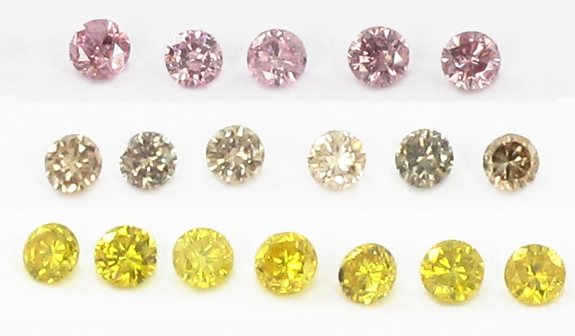 Le diamant exposé :
Le diamant exposé :
A la galerie, nous avons consacré plusieurs expositions au diamant. En 2018, nous avons exposé les dernières créations de Niessing avec de très surprenantes bagues Tension. En 2015, nous avons organisé une exposition très ludique, intitulée « Le diamant joue à cache-cache ». Les cachettes ne manquaient pas ! Elles allaient du camouflage ton sur ton, en passant par le diamant brut, qui ne brille pas, des bagues aux diamants qui courrent autour du doigt, posé dessous, dedans, de côté mais pas où on les attend et enfin un diamant caché au milieu de pierres si brillantes mais qui n’en sont pas !

